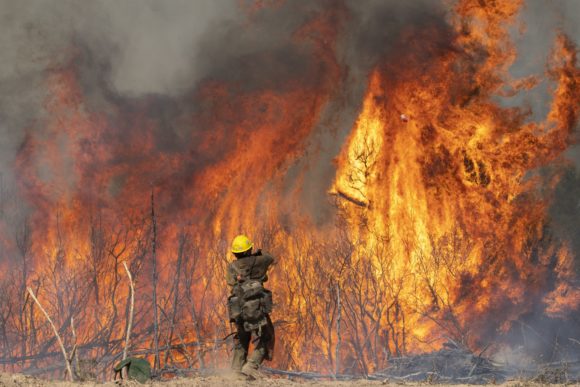Lightning’s destructive potential was showcased in 2020 when it sparked the massive California Lightning Complex fires, but it remains hard to predict.
According to a new study led by the University of Washington, machine learning can be used to improve lightning forecasts, which in turn could help to prepare for potential wildfires, improve safety warnings for lightning and create more accurate long-range climate models.
“The best subjects for machine learning are things that we don’t fully understand. And what is something in the atmospheric sciences field that remains poorly understood? Lightning,” Daehyun Kim, a UW associate professor of atmospheric sciences, said in a statement. “To our knowledge, our work is the first to demonstrate that machine learning algorithms can work for lightning.”
The new technique combines weather forecasts with a machine learning equation based on analyses of past lightning events. The hybrid method, presented Dec. 13 at the American Geophysical Union’s fall meeting, can forecast lightning over the southeastern U.S. two days earlier than the leading existing technique.
“This demonstrates that forecasts of severe weather systems, such as thunderstorms, can be improved by using methods based on machine learning,” said Wei-Yi Cheng, who did the work for his UW doctorate in atmospheric sciences. “It encourages the exploration of machine learning methods for other types of severe weather forecasts, such as tornadoes or hailstorms.”
Researchers trained the system with lightning data from 2010 to 2016, letting the computer discover relationships between weather variables and lightning strokes. Then they tested the technique on weather from 2017 to 2019, comparing the AI-supported technique and an existing physics-based method, using actual lightning observations to evaluate both.
The new method was able to forecast lightning with the same skill about two days earlier than the leading technique in places like the southeastern U.S. that get a lot of lightning. Because the method was trained on the entire U.S., its performance wasn’t as accurate for places where lightning is less common.
The approach used for comparison was a recently developed technique to forecast lightning based on the amount of precipitation and the ascent speed of storm clouds. That method has projected more lightning with climate change and a continued increase in lightning over the Arctic.
The machine learning was trained on lightning observations from the World Wide Lightning Location Network, a collaborative based at the UW that has tracked global lightning since 2008.
The researchers hope to improve their method using more data sources, more weather variables and more sophisticated techniques. They would like to improve predictions of particular situations like dry lightning, or lightning without rainfall, since these are especially dangerous for wildfires.
Topics Catastrophe Trends Natural Disasters InsurTech Wildfire Data Driven Artificial Intelligence
Was this article valuable?
Here are more articles you may enjoy.



 AT&T Says Data From Around 109M Customer Accounts Illegally Downloaded
AT&T Says Data From Around 109M Customer Accounts Illegally Downloaded  Marsh McLennan Agency to Acquire The Horton Group
Marsh McLennan Agency to Acquire The Horton Group  Project 2025 Plan to End NFIP Welcomed by Some, Rejected by Others in Insurance
Project 2025 Plan to End NFIP Welcomed by Some, Rejected by Others in Insurance  Deere Retreats From Diversity Measures After Online Attacks
Deere Retreats From Diversity Measures After Online Attacks 

